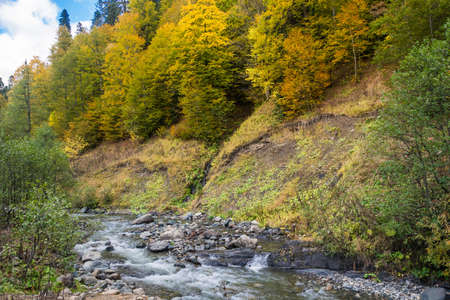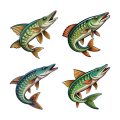Introduction to Grayling Fishing in British Waters
As the crisp air of autumn descends upon Britain’s rivers and frost begins to edge the banks, a unique angling opportunity quietly emerges: grayling fishing. Revered among British fly fishers, the grayling (Thymallus thymallus) is often referred to as the “Lady of the Stream” for its graceful form and striking dorsal fin. Autumn and winter mark a special chapter in the British fly fishing calendar, as trout season closes and rivers are left to the pursuit of this enigmatic native species. Grayling have long held a cherished place in British angling heritage, celebrated for both their beauty and sporting challenge. During these colder months, their behaviour shifts; they gather in shoals and become more responsive to carefully presented flies, rewarding anglers willing to brave the elements. For many, venturing out onto misty riverbanks on a brisk morning is not just about catching fish—it’s a quintessentially British experience, blending tradition, relaxation, and a touch of adventure. Whether you’re seeking solitude or camaraderie with fellow enthusiasts, grayling fishing in autumn and winter offers a fresh perspective on familiar waters, inviting you to discover new tactics and immerse yourself in the timeless rhythms of the countryside.
2. Understanding Cold-Weather River Conditions
As autumn gives way to winter, the character of British rivers transforms considerably. The once lively currents slow down, and the water often turns glassy under brooding grey skies—a classic UK backdrop for grayling fly fishing. This seasonal shift presents unique challenges and opportunities for anglers who know how to read the subtle cues along the riverbank and interpret water flows during the colder months.
Reading Riverbanks in Autumn and Winter
The riverbanks in Britain take on a subdued palette as leaves fall, revealing more of the river’s contours. Without summer’s lush cover, features such as undercut banks, gravel runs, and overhanging branches become more visible—prime lies for grayling seeking shelter from stronger currents or predators. Additionally, fallen leaves collect in eddies and slower pools, subtly changing fish-holding spots throughout the season.
How Water Flows Change Under Grey Skies
With lower temperatures and frequent rainfall, UK rivers can fluctuate quickly between clear and coloured conditions. Grayling favour steady flows with good oxygenation but tend to move into slower glides or deeper pools when water temperatures drop. Reading these changes is vital for effective fly presentation.
| River Condition | Typical Changes | Grayling Behaviour |
|---|---|---|
| Low & Clear | Slower current, visible bottom | Hold deeper or under cover; shy bites |
| High & Coloured | Faster current, murky water | Move to slack water; feed actively if visibility improves |
| Steady & Overcast | Mild flow, low light levels | Venture into shallower runs; more confident feeding |
Insider Tips for British Waters
Keep an eye on weather forecasts and river gauges—UK rivers respond swiftly to rain or frost. After a mild spell, grayling may feed closer to the surface in gentle riffles. Conversely, during a cold snap, target the slowest, deepest stretches where grayling conserve energy. By tuning into these subtle shifts along Britain’s waterways, you’ll unlock some of the best cold-weather grayling sport our rivers have to offer.
![]()
3. Essential Tackle and Local Fly Patterns
When it comes to autumn and winter grayling fly fishing in the UK, having the right tackle is as vital as a piping hot cuppa on a frosty morning. The British approach leans towards classic gear that’s both functional and steeped in tradition, ensuring you’re well-prepared for those bracing riverside sessions.
Traditional British Gear: Rods and Reels
A lightweight 9 to 10-foot rod rated for 2 to 4-weight lines is the gold standard for grayling, offering enough finesse for delicate presentations yet sturdy enough to handle lively fish. Choose a rod with a soft action to protect fine tippets—a must when targeting grayling with their gentle takes. Pair this with a small, traditional click-and-pawl reel; British anglers favour these not only for nostalgia but also for their reliability in cold, damp conditions.
Lines and Leaders Suited for Chilly Days
In colder months, opt for floating or double-taper lines which offer superior control at short range—ideal for nymphing or gentle upstream presentations. Keep leaders long (around 12 feet) and fine, tapering down to 3lb or even lighter if water clarity demands. A supple fluorocarbon tippet helps keep flies drifting naturally even in icy flows.
Local Fly Patterns That Shine in Winter
No discussion of British winter grayling would be complete without mentioning a few treasured local patterns. The Pink Shrimp—a staple on rivers like the Dee and Test—mimics freshwater shrimp and stands out against the subdued winter riverbed. The Grayling Bug, often tied with copper wire and buggy dubbing, is another favourite when fish are hugging the bottom. Don’t overlook classics like the Red Tag or Sawyer’s Killer Bug; both have earned legendary status among UK anglers thanks to their simple profiles and irresistible movement. Tied sparsely on barbless hooks, these flies drift just above the gravel where grayling graze, making them absolutely lethal in cold water.
Armed with traditional British gear and time-honoured local fly patterns, you’ll not only blend into the riverside scene but also increase your chances of winter success—just as generations of anglers have done before you.
4. Proven Tactics for Cold-Season Success
Drift Control: Mastering the Current
Autumn and winter on British rivers often mean fluctuating flows and challenging currents. Achieving a natural drift is critical, as grayling are notoriously fussy and will quickly spot unnatural movement. The key is to mend your line frequently, ensuring that your fly moves at the pace of the current rather than being dragged downstream. Utilise longer leaders (often up to 12ft or more) for delicate presentations, and opt for lighter tippets to reduce drag in clearer water.
Casting from Frosty Banks: Staying Steady and Safe
When banks are frosted over or slick with mud, a secure footing becomes as important as a well-tied fly. Use studded boots or wading staffs for stability. Casting can be tricky when there’s ice or overhanging branches, so employ roll casts and spey casts to keep your line clear of snags. Consider the low sun angle; polarised glasses help spot fish even when visibility is reduced by glare.
Techniques Tailored to Greyling Behaviour
During colder months, grayling tend to shoal together in deeper glides and slower runs. They feed less aggressively but remain catchable with the right approach. Nymphing is particularly effective—use weighted bugs and shrimp patterns to get down quickly. Czech nymphing or ‘tight-line’ techniques work wonders in these conditions, allowing you to stay in direct contact with your flies and detect even the faintest takes.
Recommended Nymph Patterns for Autumn & Winter
| Pattern | Colour | Size |
|---|---|---|
| Pheasant Tail Nymph | Natural/Brown | 14-18 |
| Pink Shrimp | Pink/Red | 12-16 |
| Czech Nymph | Tan/Olive | 12-16 |
| Hare’s Ear Bug | Grey/Natural | 14-18 |
Top Tips for Success on UK Waters:
- Avoid wading too deeply; greyling often sit just off the current’s edge during winter.
- Fish slowly and methodically—cover each run thoroughly before moving on.
- If you miss a take, cast again immediately; grayling are notorious for coming back to a well-presented fly.
- Keep an eye on water temperature; even a slight rise can trigger short feeding spells.
By embracing these proven tactics tailored to the unique challenges of autumn and winter in the UK, you’ll maximise your chances of connecting with spirited grayling—even when the cold bites and mornings begin with a crunch underfoot.
5. Iconic UK Destinations and Cosy Fisherman’s Retreats
There’s no better way to experience autumn and winter grayling fishing than by exploring the quintessential British rivers and charming villages that define the UK angling scene. The River Test in Hampshire, renowned for its gin-clear waters and classic chalkstream character, is a must-visit for any fly fisher. Here, the picturesque villages of Stockbridge and Whitchurch invite you to wander their high streets, with traditional outfitters and tea rooms offering a warm welcome. Further north, the River Dee in Wales winds through enchanting valleys and storybook hamlets like Llangollen, where you can fish beneath ancient stone bridges before retreating to a rustic inn.
For those seeking the wild beauty of the north, the Yorkshire Dales present the River Wharfe and its surrounding honey-stone villages, such as Grassington. After a brisk day on the water, nothing beats settling into a fireside nook at a local pub—the Devonshire Arms or The Fountaine Inn—where hearty pies and local ales are served in abundance. Scotland’s River Tweed also boasts world-class grayling sport amid rolling hills and historic market towns; consider warming up at a snug Borders lodge with a dram of whisky in hand.
Cosy fisherman’s retreats are essential after braving bracing riverbanks. Seek out heritage inns with crackling log fires, like The Trout at Tadpole Bridge along the Thames or The Hand at Llanarmon nestled deep in rural Wales. Many provide rod racks at the door, drying rooms for your kit, and even mud boots to borrow—adding to that unmistakably British sense of hospitality. For those who prefer a more private escape, boutique riverside lodges offer plush bedding and hearty breakfasts using local produce, ensuring anglers are well-fuelled for another day of adventure.
Whether you’re swapping tales with locals over a pint or unwinding in a stone cottage overlooking mist-shrouded meadows, these destinations perfectly capture the spirit of British grayling fishing: tradition, comfort, and camaraderie amid some of the most beautiful landscapes Britain has to offer.
6. Respecting the Landscape: Conservation and Local Etiquette
Angling for grayling during Britain’s crisp autumn and frosty winter months is about more than just casting a line—its a cherished tradition built on respect for nature and community. To ensure these rivers remain vibrant for generations, anglers must uphold British codes of conduct, which blend environmental stewardship with local courtesy.
Adhering to Environmental Mindfulness
British fly fishing culture places great emphasis on the principle of “leave no trace.” Dispose of all litter, including spent tippet and packaging, in designated bins. When wading or moving along riverbanks, tread lightly to avoid disturbing bankside vegetation and spawning grounds. Practise catch-and-release whenever possible; handle grayling with wet hands and release them gently to minimise stress and injury.
Collaboration with Local Communities
Joining local angling clubs not only supports conservation efforts but also fosters camaraderie among fellow enthusiasts. Many rivers are managed by trusts or associations, which often run habitat restoration projects or educational days. Respect private water rights—always seek permission before fishing unfamiliar beats and adhere strictly to club rules or posted signage regarding access, seasons, and bag limits.
Promoting Responsible Behaviour
The British angler’s code goes beyond the water’s edge. Be considerate of other countryside users such as walkers or farmers; close gates behind you and keep dogs under control if present. Share knowledge with newcomers to encourage good practice and maintain the integrity of this time-honoured pursuit. In doing so, each cast becomes part of a broader commitment to protect both fish and landscape.
By upholding these traditions of care and cooperation, anglers can enjoy the magic of autumn and winter grayling fishing while ensuring that Britain’s wild waters continue to inspire for years to come.

